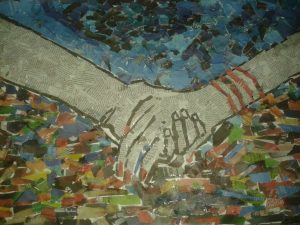 The Yogabliss on-line Moving into Meditation class met this morning. Today’s practice was about our connections – the way we relate to ourselves and one another. We explored ways of “presencing” that is, staying with what surfaces in our bodies, hearts and minds. This prepares us to be fully present in our relating – even with feelings of disconnection and loneliness. Spiritual teachings tell us that we are all interconnected, interdependent. Yet in today’s social separation and society’s fragmentation I – like many of my friends – often feel alone.
The Yogabliss on-line Moving into Meditation class met this morning. Today’s practice was about our connections – the way we relate to ourselves and one another. We explored ways of “presencing” that is, staying with what surfaces in our bodies, hearts and minds. This prepares us to be fully present in our relating – even with feelings of disconnection and loneliness. Spiritual teachings tell us that we are all interconnected, interdependent. Yet in today’s social separation and society’s fragmentation I – like many of my friends – often feel alone.
We drew on Irish poet and philosopher’s inspiration from his book: Eternal Echoes: Celtic Reflections of Our Yearning to Belong. He beautifully describes how our need to belong is at the center of our hearts. Our practice gives us the opportunity to become aware of and recognize the sensations, emotions and thoughts as signals. They often signal our unmet needs – needs that are universally human. Truly they can help us understand and connect with one another. Belonging is in the loving care we give and receive from each other.
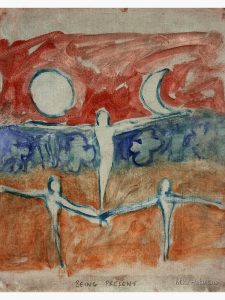 Meditation teacher and author Sebene Selassie describes belonging as a paradox. True belonging includes our longing for connection and the challenge we have in accepting ourselves and each other – it doesn’t always feel good.
Meditation teacher and author Sebene Selassie describes belonging as a paradox. True belonging includes our longing for connection and the challenge we have in accepting ourselves and each other – it doesn’t always feel good.
Finally we enjoyed Jean Valentine’s whimsical poem about relating: Sanctuary. Jean served as the State Poet of New York from 2008 to 2010. She has authored over a dozen books of poetry and taught at Columbia University, Sarah Lawrence College, New York University.
Relaxed Reflection
Let your body settle . . . feel the earth supporting you . . . feel your body breathing. Together we’ve created a sacred space, a circle of belonging. We are here together with others who value awareness, kindness and compassion. We are creating a space where people can come to understand their hearts and minds. We can reflect on what brought us here today – the deeper needs we seek to fill – kinship, healing, solace – rest or inspiration.
Irish poet and philosopher John O’Donohue writes:
 We live in a world that responds to our longing; it is a place where the echoes always return, even if sometimes slowly… The hunger to belong is at the heart of our nature. Cut off from others, we atrophy and turn in on ourselves. The sense of belonging is the natural balance of our lives… There is some innocent childlike side to the human heart that is always deeply hurt when we are excluded… When we become isolated, we are prone to being damaged; our minds lose their flexibility and natural kindness; we become vulnerable to fear and negativity.
We live in a world that responds to our longing; it is a place where the echoes always return, even if sometimes slowly… The hunger to belong is at the heart of our nature. Cut off from others, we atrophy and turn in on ourselves. The sense of belonging is the natural balance of our lives… There is some innocent childlike side to the human heart that is always deeply hurt when we are excluded… When we become isolated, we are prone to being damaged; our minds lose their flexibility and natural kindness; we become vulnerable to fear and negativity.
These words seem especially meaningful. Today we distance eachother in order to safeguard our health. Our social contacts and activities are bound into smaller and smaller circles. At times the belonging that John describes as “the natural balance of our lives” seems to be lost. Life is out of balance. We do feel “vulnerable to fear and negativity.”
We are not separate from each other. The spiritual foundation of mindfulness practice rests on the direct experience of our interconnection. The idea of interconnection speaks to our minds. And yet in our hearts we often do feel separate and alone.
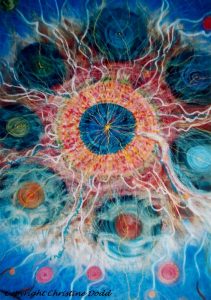 Right now we can consider the most recent experience of belonging that we’ve enjoyed. What were the circumstances? Who were we with? What were doing? What were the emotions that surfaced? The physical sensations in the body? How long did that sense of connection last?
Right now we can consider the most recent experience of belonging that we’ve enjoyed. What were the circumstances? Who were we with? What were doing? What were the emotions that surfaced? The physical sensations in the body? How long did that sense of connection last?
Right now we can reflect about how we separate ourselves. How do we step out of our circle of belonging? Are these conscious choices? What conditions, what forces move us to separate? Did we suffer physical or emotional pain? Did we abandon ourselves or reject another?
We alternately experience belonging and separation. This is reflected in the fragmented and polarized society we live in. In our mindfulness practice we can reflect on how we are relating – to ourselves and to one another. Are we bringing qualities of openness, curiosity, kindness and compassion? What is the the relationship you hold with yourself like? Is the tone of your inner voice critical or kind? Is it truthful or biased? How does your body respond to hearing that voice?
We can consider how we relate to others. Are we able to hear differences of opinion? Can we adapt to different communication styles? How do we respond to different ways of being? Perhaps the most important question is what is motivating our relating? Do we seek to understand? If so, how do we practice understanding?
 In mindfulness practice we begin with awareness. Awareness of sensations of the body, emotions in the heart and thoughts in the mind. So often sensation, emotion and thought signal an underlying need. These signals – these unmet needs – can be uncomfortable – even distressing. Can we stay present long enough to allow the awareness of our inner needs to surface? Long enough to recognize that the person with whom we are relating is also experiencing needs. Which brings us back to John O’Donohue’s words: “The hunger to belong is at the heart of our nature.”
In mindfulness practice we begin with awareness. Awareness of sensations of the body, emotions in the heart and thoughts in the mind. So often sensation, emotion and thought signal an underlying need. These signals – these unmet needs – can be uncomfortable – even distressing. Can we stay present long enough to allow the awareness of our inner needs to surface? Long enough to recognize that the person with whom we are relating is also experiencing needs. Which brings us back to John O’Donohue’s words: “The hunger to belong is at the heart of our nature.”
There is a lovely balance at the heart of our nature: each of us is utterly unique and yet we live in the most intimate kinship with everyone and everything else… Our hunger to belong is the desire to awaken this hidden affinity.
Meditation instructor and author Sebene Selassie writes:
We all belong to absolutely everyone and everything.
To. ALL. Of. It.
This does NOT necessarily feel good.
 She describes this belonging as a paradox in which we are challenged to accept otherness in our circle of belonging. This includes the otherness we make within ourselves – our conditioning, our stories, our shadows. This includes the otherness we make of eachother. This includes the assumptions, the ideas, the misperceptions that we are often unaware of. In relating – however imperfect – what is unconscious can be revealed. If we can bring a willingness to stay engaged, even the hidden motivations we have to avoid what might be painful to see.
She describes this belonging as a paradox in which we are challenged to accept otherness in our circle of belonging. This includes the otherness we make within ourselves – our conditioning, our stories, our shadows. This includes the otherness we make of eachother. This includes the assumptions, the ideas, the misperceptions that we are often unaware of. In relating – however imperfect – what is unconscious can be revealed. If we can bring a willingness to stay engaged, even the hidden motivations we have to avoid what might be painful to see.
Sanctuary
by Jean Valentine
People pray to each other. The way I say “you” to someone else,
respectfully, intimately, desperately. The way someone says
“you” to me, hopefully, expectantly, intensely …
—Huub Oosterhuis
You who I don’t know I don’t know how to talk to you
—What is it like for you there?
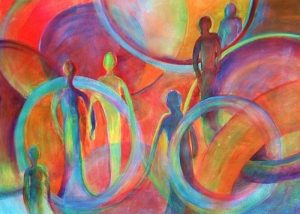 Here … well, wanting solitude; and talk; friendship—
Here … well, wanting solitude; and talk; friendship—
The uses of solitude. To imagine; to hear.
Learning braille. To imagine other solitudes.
But they will not be mine;
to wait, in the quiet; not to scatter the voices—
What are you afraid of?
What will happen. All this leaving. And meetings, yes. But death.
What happens when you die?
“… not scatter the voices,”
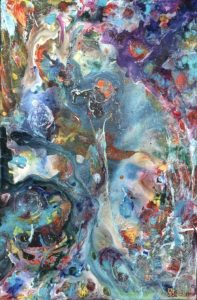 Drown out. Not make a house, out of my own words. To be quiet in
Drown out. Not make a house, out of my own words. To be quiet in
another throat; other eyes; listen for what it is like there. What
word. What silence. Allowing. Uncertain: to drift, in the
restlessness … Repose. To run like water—
What is it like there, right now?
Listen: the crowding of the street; the room. Everyone hunches in
against the crowding; holding their breath: against dread.
What do you dread?
What do you dread, in this room, now?
Not listening. Now. Not watching. Safe inside my own skin.
To die, not having listened. Not having asked … To have scattered
life.
Yes I know: the thread you have to keep finding, over again, to
follow it back to life; I know. Impossible, sometimes.

